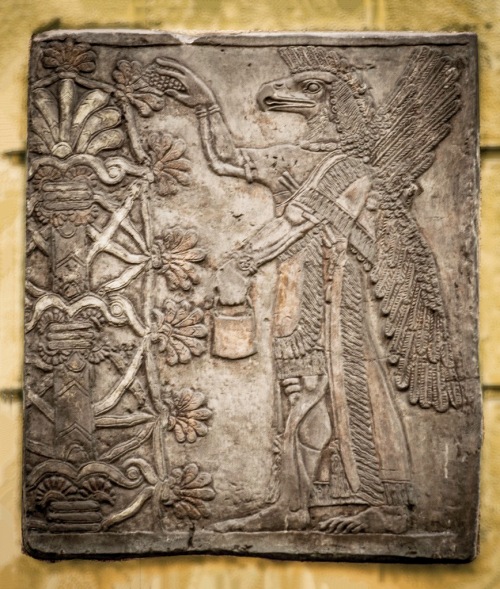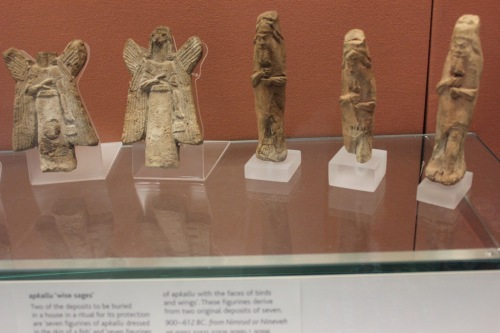Why No Canonical Literature Regarding the Apkallu?
“In adducing the motif of the “wise vizier”, I have only meant to show that the “wise men” of a tradition are not necessarily kings, and furthermore, to show the complexity of a problem that, if I do not pretend to solve, I neither am inclined to embezzle.
In my opinion, the myth of the apkallu’s in all likelihood reflects the etiological story which the Greek accounts attempt to render, but which did not survive in the Mesopotamian canonical literature.

This winged umu-apkallū raises his right arm in the greeting gesture, with the banduddu water bucket in his left hand. The headdress is unusual, not the usual horned tiara, but a headband with a rosette insignia.
Beside the reference to the “old sages from before the flood” (AMT 105:22, last cited by Lambert, JCS 11 p. 8), an allusion to the presence on earth, before the flood, of apkallu’s, who after the flood regained the Apsû, is contained in the Epic of Era, where Marduk says that he “made these wise men go down to the Apsû” (ummânī šunūti ana apsî ušēridma, I 147), together with the precious materials needed to fashion the divine statute.
In the following rhetorical questions in which he regrets that neither the materials, nor the craftsmen needed to work them are available, Marduk finally deplores the absence of the sages who, most likely, were the only ones capable of infusing life into the divine statue: ali sibīt apkallī (NUN.ME) apsî purādī ebbūti ša kīma Ea bēlišunu uzna sīrtu šuklulu (I 162) “Where are the seven sages of the Apsû, the pure purādu-fish, who, just as their lord Ea, have been endowed with sublime wisdom?”. […]

In Neo-Assyrian art these bird-headed “genies,” as they were long described, are now known to be apkallū, “bird-apkallū,” in this case, mixed-feature exorcists and creatures of protection created by the god Ea. They traditionally served as advisors to kings. Their association with sacred trees, as they are often portrayed, remains somewhat perplexing.
This apkallū makes the iconic gesture of exorcism and liberation of sin with the mullilu cone in his raised right hand, and the banduddu water bucket in his left hand.
There are three known types of apkallū: the human, with wings; the avian-headed, with wings, and the fish-apkallū, with carp skin draped over their heads.
https://www.flickr.com/photos/lanpernas2/8606000868/
The story here edited cannot be interpreted as an etiological myth. Neither the exploits of the apkallu’s, nor even their names suggest any literary figure known to us, with the exception of Adapa, nor are they said to have existed in the period before the flood.
Meager evidence is the mention of the apkallu from Ur, Lu-Nanna, in the colophon of a text (K 8080, see Lambert, JCS 11 p. 7) listing poultices for magical purposes and of Piriggalabzu in the incipit of a Sumerian t i g i -song. …
On the other hand, two apkallu’s not described among the heroes of our text — who, as the reader must have noted, are only five in number — are mentioned as authors: a certain Enlil-muballit, apkallu of Nippur under Enlil-bani of Isin, in AMT 105:24 (see Lambert, JCS 11 p. 8), and a certain Ur-Gatumduga in the subscript to the Šulgi-hymn PBS 1/1 No. 11 …
There is little hope that we will ever find more ample material dealing with the apkallu’s. Of the legend, or cycle of legends, concerning their exploits what our texts tells us alone survives.
Indeed, we may even assume that at the time of its redaction the details of the legendary events had already faded into the past. Only the legend of Adapa must have still been well known, for concerning him the text contents itself with an even briefer allusion than its report on the other apkallu’s.
The very terseness of the characterization of each apkallu reminds us of the style of the so-called “historical omens” attached to the early kings, many of which are better considered anecdotes, as has been suggested by Güterbock, ZA 42 57 ff.
Just as historical texts never mention the exploits of Narām-Sin, Sargon, and others, that are referred to in these omens, so literary texts, transmitting always the same written tradition, have not recorded the feats of the apkallu’s.

Antediluvian apkallū portrayed as fish-men, such mixed-species creatures were the teachers of men.
These specific statuettes were buried in the foundations of the home of an exorcist, where they were positioned beneath doorways and against particular walls to exert a prophylactic effect, warding off evil.
The antediluvian type of apkallū, the so-called purādu-fish, are often grouped in sevens.
It certainly seems as if the scribes deliberately suppressed a cycle dealing with those human beings who, at one or other of history, and no doubt with the connivance of Ea, revolted against the gods and “brought down Ištar from heaven into Eanna,” or “aroused Adad’s anger” by some forgotten or perhaps unmentionable act, or “angered Ea” through some form of challenge which is still obscure to us, in spite of the three duplicates we now have of this allusion.
Even the learned Lu-Nanna is not included for his literary achievements, but for a feat, we suspect, disrespectful to the goddess.
These acts of hubris seem quite irreconcilable with the picture we have formed of the Mesopotamian attitude towards the gods on the basis of traditional literature, and they must have been the cause of the eventual oblivion from which, however, the memory of some admirable human achievement persistently drew out again the figures of the “possessors of unsurpassed wisdom,” the sages.”
Erica Reiner, “The Etiological Myth of the “Seven Sages,” Orientalia, v. 30, No. 1, 1961, pp. 9-11.


